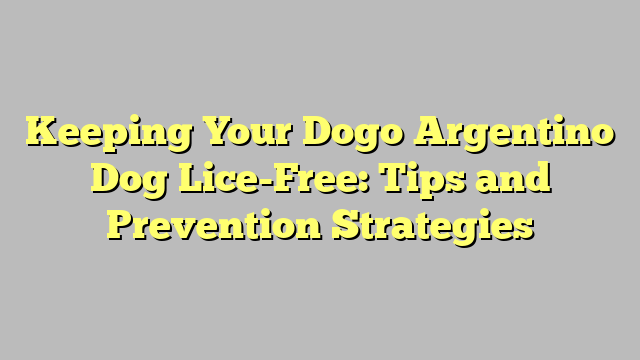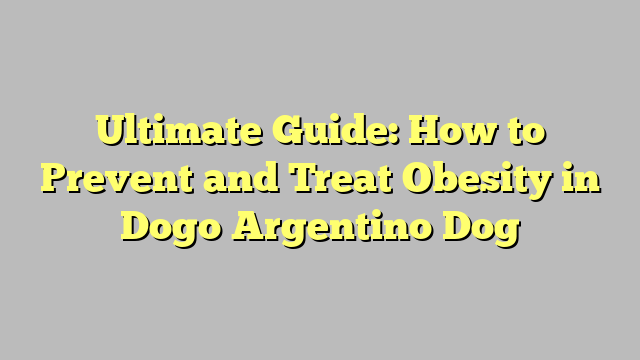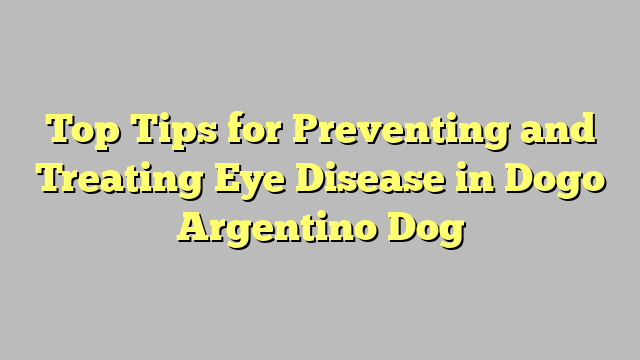
Keeping Your Dogo Argentino Dog Lice-Free: Tips and Prevention Strategies
Learn effective tips and prevention strategies to keep your Dogo Argentino Dog lice-free.
Brief overview of the Dogo Argentino Dog breed
The Dogo Argentino Dog is a rare breed of bulldog that originated in the United States. Known for their strong and muscular build, these dogs were originally bred for working on farms and protecting livestock. They are characterized by their distinctive coat, which can come in a variety of colors including blue, red, and chocolate. This breed is known for its loyalty and protective nature, making them excellent guard dogs and family pets.
Physical Characteristics
The Dogo Argentino Dog is a medium to large-sized breed with a muscular build and a powerful jaw. They have a short, smooth coat that is easy to maintain, and their distinctive facial wrinkles give them a unique appearance. Their ears are typically half-pricked or rose-shaped, adding to their distinctive look. These dogs are known for their strength and agility, making them well-suited for various working roles.
Temperament and Behavior
Dogo Argentino Dog are known for their loyal and protective nature. They are devoted to their families and are naturally wary of strangers, making them excellent guard dogs. However, with proper socialization and training, they can also be gentle and affectionate companions. This breed is known for being intelligent and eager to please, making them relatively easy to train. They thrive in a home environment where they receive plenty of attention and exercise.
Explanation of the importance of preventing lice infestations in dogs
Lice infestations in dogs can cause a range of health issues, including itching, irritation, and even skin infections. Preventing lice infestations is crucial for maintaining the overall health and well-being of your dog. Regular grooming and using preventative treatments can help to keep lice at bay and ensure that your dog remains comfortable and healthy.
Health Risks
Lice infestations can lead to a variety of health risks for dogs, including anemia, skin infections, and allergic reactions. Severe infestations can also cause hair loss and lead to a decline in the dog’s overall health. By preventing lice infestations, you can help to avoid these potential health issues and ensure that your dog remains happy and healthy.
Preventative Measures
There are several preventative measures that dog owners can take to reduce the risk of lice infestations. Regular grooming, including brushing and bathing, can help to keep lice at bay. Additionally, using preventative treatments such as lice-repellent shampoos and spot-on treatments can provide an extra layer of protection. It’s important to consult with a veterinarian to determine the best preventative measures for your specific dog and to ensure that any products used are safe and effective.
Explanation of the types of lice that can affect dogs
Sucking Lice
Sucking lice, also known as Anoplura, are one of the two main types of lice that can affect dogs. These lice feed on the blood of the dog and can cause irritation, itching, and discomfort. They are usually found in areas with less hair, such as the ears, groin, and armpits of the dog. Sucking lice can be easily identified by their long, narrow, and piercing mouthparts.
Biting Lice
Biting lice, also known as Mallophaga, are the other main type of lice that can affect dogs. Unlike sucking lice, biting lice feed on the skin and debris of the dog, rather than blood. They are usually found in areas with more hair, such as the back and tail of the dog. Biting lice can cause similar symptoms as sucking lice, including itching and irritation.
Understanding the types of lice that can affect dogs is important for pet owners to be able to identify and treat infestations. Regular grooming and inspection of the dog’s coat can help in early detection and treatment of lice. It is also important to consult a veterinarian for proper diagnosis and treatment options for lice infestations in dogs.
Signs and symptoms of lice infestations in Dogo Argentino Dog
Lice infestations in Dogo Argentino Dog can cause a range of symptoms that may indicate their presence. One of the most common signs of lice infestation is excessive scratching and biting, particularly around the neck, ears, and base of the tail. You may also notice redness, irritation, and small scabs on the skin as a result of the constant scratching. Additionally, lice eggs, known as nits, may be visible in the dog’s fur, appearing as small white or yellowish specks attached to individual hairs.
Other symptoms to watch for include:
– Restlessness or agitation
– Hair loss or thinning in affected areas
– Presence of adult lice moving through the fur
– Skin inflammation or infection
If you notice any of these symptoms in your Dogo Argentino Dog, it’s important to consult with a veterinarian for proper diagnosis and treatment. Lice infestations can be uncomfortable for your pet and may lead to secondary skin infections if left untreated. Early detection and intervention are key to managing lice infestations effectively.
Regular grooming and inspection
Regular grooming and inspection of your body is important for maintaining good hygiene and overall health. Grooming includes activities such as bathing, brushing your teeth, and keeping your hair and nails clean and trimmed. Regular inspection involves checking your skin for any unusual moles or spots, as well as monitoring your overall physical health.
Benefits of regular grooming and inspection
By incorporating regular grooming and inspection into your routine, you can prevent potential health issues and maintain a clean and well-groomed appearance. Grooming helps to remove dirt, bacteria, and dead skin cells from your body, reducing the risk of infections and skin problems. Regular inspection allows you to detect any changes in your body early on, which can be crucial for identifying potential health concerns.
In addition to the physical benefits, regular grooming and inspection can also contribute to your mental well-being. Taking care of your appearance and being mindful of your body can boost your self-esteem and confidence. It also allows you to develop a deeper understanding of your body and its needs, leading to a more holistic approach to self-care.
Use of veterinarian-approved lice prevention products
When it comes to preventing lice in your pets, it’s important to use products that have been approved by a veterinarian. These products are specifically formulated to effectively prevent and treat lice infestations while also being safe for your pet’s health. Veterinarian-approved lice prevention products undergo rigorous testing to ensure their efficacy and safety, giving pet owners peace of mind when using them on their furry friends.
Benefits of using veterinarian-approved lice prevention products:
– Veterinarian-approved lice prevention products are designed to specifically target lice and prevent infestations, providing a more targeted and effective solution compared to over-the-counter products.
– These products are formulated to be safe for use on pets, minimizing the risk of adverse reactions or side effects.
– Veterinarian-approved lice prevention products often come with detailed instructions on how to use them properly, ensuring that pet owners can effectively apply the product for maximum effectiveness.
By using veterinarian-approved lice prevention products, pet owners can take proactive measures to protect their pets from lice infestations, promoting their overall health and well-being.
Cleaning and sanitizing your dog’s environment
Keeping your dog’s environment clean and sanitized is essential for their health and well-being. Start by regularly cleaning your dog’s bedding, toys, and any other items they frequently come into contact with. Use a pet-safe detergent and hot water to wash their bedding and toys, and be sure to thoroughly dry everything to prevent the growth of bacteria and mold.
Regular vacuuming and mopping
In addition to washing your dog’s belongings, it’s important to regularly vacuum and mop the floors in your home, especially in areas where your dog spends a lot of time. Dog hair, dander, and dirt can build up quickly, creating an environment that is ripe for bacteria and pests. Use a pet-friendly floor cleaner to sanitize the floors and keep your dog’s living space clean and healthy.
Regular grooming and bathing
Regular grooming and bathing are also essential for keeping your dog’s environment clean. Brushing your dog regularly helps to remove loose hair and prevent mats, while bathing helps to remove dirt and odors. Be sure to use a gentle, pet-safe shampoo and thoroughly dry your dog after their bath to prevent skin issues. By keeping your dog clean and well-groomed, you can help maintain a healthy and sanitized environment for them to live in.
Avoiding contact with infested animals
Why it’s important
Avoiding contact with infested animals is crucial in preventing the spread of diseases and parasites. Infested animals can carry a variety of harmful organisms such as ticks, fleas, and mites that can transmit diseases to humans. By avoiding contact with infested animals, you can reduce the risk of contracting these illnesses and protect your health.
How to avoid contact
There are several ways to avoid contact with infested animals. First, it’s important to be aware of the signs of infestation, such as excessive scratching, hair loss, or visible parasites on the animal’s fur. If you encounter an animal that appears to be infested, it’s best to keep your distance and avoid touching or handling the animal. Additionally, it’s important to keep your own pets treated for parasites to reduce the risk of infestation in your home.
By following these guidelines, you can minimize the risk of coming into contact with infested animals and protect yourself from potential health hazards.
Regularly washing your dog’s bedding and toys
Keeping your dog’s bedding and toys clean is essential for their health and well-being. Just like humans, dogs can be sensitive to dust, dirt, and allergens that can accumulate on their bedding and toys. Regular washing can help prevent the buildup of these irritants and keep your dog comfortable and healthy.
Benefits of regular washing
Washing your dog’s bedding and toys regularly can help prevent the spread of bacteria and parasites that can cause skin irritations and infections. It can also help eliminate odors and keep your home smelling fresh. Additionally, clean bedding and toys can help reduce the risk of allergies and respiratory issues for both your dog and your family members.
Tips for washing
When washing your dog’s bedding and toys, it’s important to use pet-safe detergents and to follow the care instructions on the labels. Bedding should be washed in hot water and dried on high heat to kill any bacteria and parasites. Toys can be washed with mild soap and water and should be thoroughly dried to prevent mold and mildew growth. It’s also a good idea to regularly vacuum and clean the area where your dog’s bedding is located to further reduce the risk of allergens and irritants. By incorporating regular washing into your dog’s care routine, you can help ensure their comfort and well-being.
Maintaining a clean and healthy living environment for your dog
Maintaining a clean and healthy living environment for your dog is essential for their overall well-being. Regularly cleaning your dog’s living space, such as their bed, crate, and designated area in the house, can help prevent the buildup of dirt, bacteria, and parasites. This can also reduce the risk of skin infections and respiratory issues for your furry friend. Additionally, providing your dog with a clean and comfortable environment can contribute to their mental and emotional health, as they will feel safe and secure in their space.
In addition to regular cleaning, it’s important to ensure that your dog has access to fresh water and a balanced diet. Keeping their water bowl clean and filled with fresh water at all times is crucial for their hydration and overall health. Furthermore, providing them with nutritious food and feeding them on a regular schedule can help maintain their energy levels and support their immune system. Consider consulting with a veterinarian to determine the best diet for your dog based on their breed, age, and any specific health concerns they may have.
Regular grooming and exercise
In order to maintain a clean and healthy living environment for your dog, it’s important to prioritize regular grooming and exercise. Brushing your dog’s coat, trimming their nails, and cleaning their ears can help prevent the buildup of dirt, bacteria, and parasites. This can also contribute to their overall comfort and well-being. Additionally, providing your dog with regular exercise, such as daily walks and playtime, can help them stay physically and mentally stimulated. This can also prevent behavioral issues and promote a healthy weight. By incorporating these practices into your dog’s routine, you can ensure that they are living in a clean and healthy environment that supports their overall health and happiness.
Explanation of how veterinarians can help prevent and treat lice infestations
Prevention
Veterinarians can provide valuable guidance on preventing lice infestations in animals. They may recommend regular grooming and hygiene practices, such as bathing and brushing, to keep the animal’s coat clean and free from lice. Additionally, veterinarians can advise on the use of preventive products, such as lice-repellent shampoos or spot-on treatments, to reduce the risk of infestation.
Treatment
When it comes to treating lice infestations, veterinarians are equipped with the knowledge and expertise to recommend the most effective course of action. They may prescribe medicated shampoos or topical treatments to eliminate lice and their eggs from the animal’s coat. In severe cases, veterinarians may also administer oral medications or injections to eradicate the infestation. Furthermore, veterinarians can provide guidance on environmental decontamination to prevent re-infestation, such as washing bedding and grooming tools, and treating the animal’s living area.
The role of preventive medications and treatments
Preventive medications and treatments play a crucial role in maintaining overall health and well-being. These interventions are designed to reduce the risk of developing certain health conditions or to manage existing conditions in order to prevent them from worsening. This can include a range of approaches such as vaccinations, regular screenings, and lifestyle modifications. By taking proactive steps to prevent illness, individuals can potentially avoid the need for more invasive and costly treatments down the line.
Benefits of preventive medications and treatments
– Reduced risk of developing certain diseases
– Improved management of chronic conditions
– Potential cost savings in healthcare expenses
– Enhanced quality of life and well-being
Types of preventive medications and treatments
– Vaccinations for infectious diseases
– Screening tests for early detection of conditions such as cancer and heart disease
– Lifestyle modifications such as diet, exercise, and stress management
– Medications to lower risk factors for certain conditions, such as cholesterol-lowering drugs for heart disease prevention
Addressing misconceptions about lice and their infestations
1. Lice infestations are a sign of poor hygiene
One common misconception about lice infestations is that they are a sign of poor hygiene. In reality, lice can infest anyone, regardless of their cleanliness. Lice are spread through close personal contact, such as sharing hats, combs, or brushes, and are not necessarily a reflection of a person’s personal hygiene habits. It is important to educate the public about this misconception to reduce the stigma and shame associated with lice infestations.
2. Lice infestations can be treated with over-the-counter products
Another misconception is that lice infestations can be easily treated with over-the-counter products. While there are many over-the-counter treatments available, lice have developed resistance to some of these products, making them less effective. It is important for people to understand that lice infestations may require prescription treatments and thorough cleaning of personal belongings to fully eradicate the infestation.
By addressing these misconceptions and providing accurate information about lice and their infestations, we can help reduce the stigma and misunderstanding surrounding this common issue. It is important to provide credible and trustworthy information to ensure that people are well-informed and can take the necessary steps to effectively treat and prevent lice infestations.
Providing accurate information on lice prevention and treatment
When it comes to lice prevention and treatment, it is crucial to provide accurate and reliable information to the public. This includes offering advice on how to prevent lice infestations, as well as providing effective treatment options for those who are already dealing with an infestation. It is important to ensure that the information provided is based on scientific evidence and best practices in the field of lice prevention and treatment.
Prevention
One key aspect of providing accurate information on lice prevention is to educate the public on the best practices for avoiding lice infestations. This may include tips on how to avoid sharing personal items such as hats and hairbrushes, as well as guidance on how to recognize the early signs of lice infestations. By providing accurate information on prevention, individuals can take proactive steps to reduce their risk of encountering lice.
Treatment
In addition to prevention, it is important to offer accurate information on the treatment of lice infestations. This may involve discussing over-the-counter and prescription treatment options, as well as addressing any misconceptions or myths about lice treatment. By providing accurate and reliable information on treatment, individuals can make informed decisions about how to effectively address a lice infestation.
Recap of the importance of preventing lice infestations in Dogo Argentino Dog
Lice infestations can cause a range of health issues for Dogo Argentino Dog, including itching, irritation, and even skin infections. In severe cases, lice infestations can lead to anemia and other serious health problems. It is crucial for Dogo Argentino Dog owners to take preventive measures to protect their pets from lice infestations.
Preventive Measures
– Regular grooming and inspection of your Dogo Argentino Dog’s coat
– Use of lice prevention products recommended by veterinarians
– Keeping your dog’s living environment clean and free of lice
By taking these preventive measures, Dogo Argentino Dog owners can significantly reduce the risk of lice infestations and ensure the health and well-being of their beloved pets.
Final tips and reminders for keeping your dog lice-free
Regular grooming
Regular grooming is essential for keeping your dog lice-free. Brushing your dog’s fur regularly can help you spot any signs of lice infestation early on. Additionally, giving your dog regular baths with a lice-repelling shampoo can help prevent lice from infesting your dog’s fur.
Keep your dog’s environment clean
Lice can easily spread in a dirty environment, so it’s important to keep your dog’s living area clean. Regularly wash your dog’s bedding and vacuum the areas where your dog spends time. This can help prevent lice from spreading and re-infesting your dog.
Avoid contact with infested animals
If you know of any dogs that are infested with lice, it’s best to avoid letting your dog come into contact with them. Lice can easily transfer from one animal to another, so minimizing contact with infested animals can help prevent lice infestation in your dog.
By following these final tips and reminders, you can help keep your dog lice-free and ensure their overall health and well-being.
In conclusion, preventing lice in Dogo Argentino Dog requires regular grooming, inspection, and treatment with vet-approved preventive products. Additionally, maintaining a clean environment and avoiding contact with infested animals are important measures to keep lice at bay.





